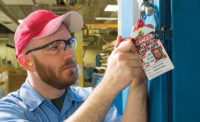 By Jim Harris, Ph.D., P.E. ; Susan Afanuh, MA; Frank Renshaw, Ph.D., CIH, CSP; David L. Parker, MD, MPH; Theodore Braun, MBA; Thomas Cunningham, PhD
By Jim Harris, Ph.D., P.E. ; Susan Afanuh, MA; Frank Renshaw, Ph.D., CIH, CSP; David L. Parker, MD, MPH; Theodore Braun, MBA; Thomas Cunningham, PhD
The food manufacturing industry includes animal slaughtering as well as the processing and packaging of meat, dairy, fruit, vegetable, grain, seafood, beverages, and bakery products. The industry employs nearly 1.5 million workers.1 Work in food manufacturing is typically fast-paced and workers can face exposure to hazards such as slips trips and falls, musculoskeletal disorders, and machine-related injuries.2
Although there has been improvement in recent years, workers in food manufacturing have a higher rate of injuries and illnesses than workers in private industry as a whole. For example, in 2012, the injury and illness rate in food manufacturing was 5.4 per 100 workers compared with 3.4 per 100 workers for private industry overall.3 That same year, food manufacturers suffered 18,620 lost-time injuries and 41 fatalities. The estimated cost for those lost-time injuries was over $1.4 billion (direct and indirect costs, at an average $76,000 each).4
Many of the machine-related injuries are related to failure to use lockout/tagout (LO/TO) procedures. An examination of OSHA’s Accident Investigation database (using SIC codes 201-207) showed that from 2003-2013, 28 fatalities and 227 serious injuries (such as amputations) were related to lockout procedures in food manufacturing.5 The largest number of incidents occurred in meatpacking and poultry slaughtering and processing.5 In fact, violation of the lockout/tagout standard (1910.147) was the most frequently cited infraction of an OSHA standard during 2012?2013 in food manufacturing with penalties totaling over $894,000.6
The NIOSH NORA Manufacturing Sector Council members want to help small food manufacturers with LO/TO, and through this blog we are seeking input from our stakeholders to enhance our understanding of the issues surrounding LO/TO in the food and beverage processing industry.
The Pace Challenge
A robust lockout/tagout program that protects the safety and health of workers is an important part of machine maintenance. Machine injuries related to lockout/tagout often occur when an employee services or repairs a machine or tries to clear a jam but fails to de-energize the machine and lock out sources of energy.
Smaller businesses face the challenge of remaining competitive in the food and beverage processing industry, and we know most companies are struggling to keep up with a bustling pace and narrow profit margins.
Pace equals profit in this industry, but workers need to stay safe while maintaining their pace. The efficient work that keeps businesses viable and competitive requires well maintained machines and equipment.
Pace does not have to be a tradeoff for safety; optimal levels of both can be achieved.



